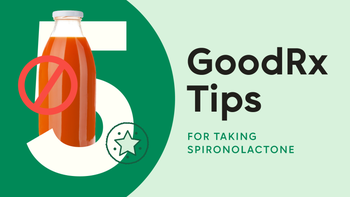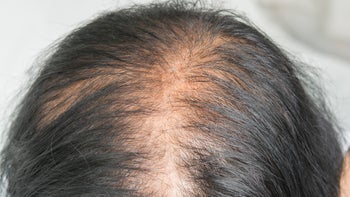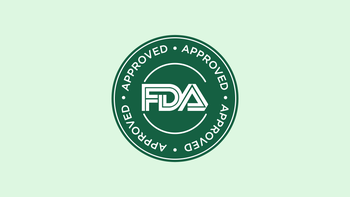
13 Spironolactone (Aldactone) Side Effects to Consider
Key takeaways:
Spironolactone (Aldactone) is a type of diuretic (“water pill”). It’s prescribed for several health conditions, such as heart failure, high blood pressure, and fluid buildup.
The most common spironolactone side effects are high potassium levels and breast tenderness. Muscle cramps, low sex drive, and low sodium levels are also possible.
Anyone taking spironolactone, regardless of their gender, may notice more pronounced feminine characteristics, such as breast growth. The medication can also cause irregular menstrual cycles.
Access savings on related medications
Table of contents

Spironolactone (Aldactone) is an older medication, originally approved by the FDA in 1960. It belongs to a group of medications called mineralocorticoid receptor antagonists.
Spironolactone works by blocking a hormone called aldosterone. This hormone helps balance certain electrolytes, blood volume, and blood pressure. Spironolactone is also a type of diuretic (“water pill”). This means it removes extra fluid from the body through urination. These actions make this medication helpful for several different health conditions.
Even though spironolactone has been around for a long time, it’s still commonly prescribed today. However, there are some notable side effects of spironolactone to know about.
Save up to 60% on Farxiga
Healthy heart for less. Pay as little as $288 for 30 tablets of Farxiga with GoodRx - no insurance needed.

What is spironolactone used for?
Spironolactone is FDA approved to treat a few health conditions:
Heart failure with reduced ejection fraction
High blood pressure when prescribed with other medications
Swelling caused by fluid buildup (edema), often due to liver or kidney damage
Primary hyperaldosteronism, a condition where the body makes too much of the hormone aldosterone
Spironolactone is also sometimes prescribed for other conditions in ways that aren’t FDA approved. This is called “off-label” use. Common off-label uses for spironolactone include:
Polycystic ovary syndrome (PCOS)
Hirsutism (male-pattern hair growth in women)
Part of estrogen-based gender-affirming hormone therapy (GAHT)
Spironolactone side effects at a glance
Like all medications, spironolactone has side effects. Many are mild and get better or go away as your body adjusts to the medication. Others are more serious and warrant medical attention.
Common spironolactone (Aldactone) side effects include:
Mildly higher blood potassium levels
Mildly low blood sodium levels
Breast pain or tenderness
Muscle cramps, especially in the legs
More pronounced feminine characteristics, such as breast growth
More frequent urination
Irregular menstrual cycles
Decreased libido (sex drive)
Erectile dysfunction
Fatigue
Dizziness
Headache
Nausea
Vomiting
Diarrhea
Severe spironolactone (Aldactone) side effects include:
Severely high blood potassium levels
Severely low blood sodium levels
Dehydration
Stomach bleeding or ulcers
Confusion
Loss of balance
Skin rashes
Kidney problems
Below, we’ll review 13 notable spironolactone side effects.
What is spironolactone used for? Learn about the FDA-approved and off-label uses of spironolactone, from heart failure to hair loss.
What foods should you avoid when taking spironolactone? These pharmacist-backed tips can help you get the most out of your medication.
Spironolactone vs. Retin-A: Here’s how these two acne treatments compare.
1. High potassium levels
Spironolactone can cause high blood potassium (hyperkalemia). Your prescriber will likely check your potassium regularly while you’re taking spironolactone to make sure it’s not too high. If your potassium levels rise too much, your spironolactone dosage may need to be lowered or stopped.
High potassium is a common spironolactone side effect. It’s usually mild and symptom-free. But it can become serious for some people. In severe cases, it can cause heart rhythm problems. Symptoms of high potassium can be mild and easily missed. So, it’s best to follow your prescriber’s instructions for getting blood tests done while taking spironolactone.
People who have health conditions that cause high potassium, such as Addison’s disease, should avoid spironolactone. This is because they’re more likely to develop severely high potassium. Some people with kidney problems may need to avoid spironolactone as well.
High potassium levels are also more likely to happen if you take certain medications. This includes some common blood pressure medications and nonsteroidal anti-inflammatory drugs (NSAIDs). Make sure to share your current medication list with your healthcare team. They’ll be able to tell you if it’s safe to take spironolactone along with your other medications.
2. Breast tenderness
Breast tenderness is usually a mild spironolactone side effect. But it can be frustrating and uncomfortable. Wearing loose-fitting shirts or a more supportive bra may help with breast pain. Applying warm or cool compresses to the area can also be soothing. Be aware that breast tenderness can happen to both men and women taking spironolactone.
Let your prescriber know if you experience this side effect. Sometimes, taking a lower dose of spironolactone will help. Other times, you may need to stop the medication to relieve this side effect.
3. Muscle cramps (especially in the legs)
Spironolactone can also cause muscle cramps, particularly in the legs. Many people find this to be most noticeable at night while sleeping. This spironolactone side effect is likely caused by changing fluid and electrolyte levels.
Leg or other muscle cramps should get better or go away after your body adjusts to spironolactone. Staying hydrated, massaging your muscles, and taking hot showers can help relieve cramps. If cramps become bothersome or seem severe, contact your prescriber for next steps.
4. More pronounced feminine characteristics
Spironolactone can lower testosterone production throughout the body. This can cause the development of feminine characteristics for some people taking it. One example is male breast growth (gynecomastia). This may be a desired effect of the medication if it's being taken as part of GAHT. But for people not taking spironolactone for GAHT, breast growth can be upsetting.
These side effects usually lessen or go away if your dose is lowered. There may also be alternative treatments for your condition. Let your prescriber know if you experience these effects and they’re unwanted.
5. Urinating more than usual
All diuretics, including spironolactone, can cause you to urinate more than usual. While this is helpful for removing extra fluid, it can be annoying. It may be most noticeable right after you start the medication or following a dose increase.
Many people take spironolactone once a day. In this case, consider taking your dose in the morning. This can help prevent you from waking overnight to use the bathroom.
If this side effect becomes too bothersome or seems excessive, let your healthcare team know. Depending on why you’re taking spironolactone, there may be other options to treat your health condition.
6. Decreased sex drive
Loss of libido can also happen due to spironolactone’s effects on testosterone. Some people may also experience erectile dysfunction (ED).
Libido usually improves on lower doses of spironolactone or after it’s stopped. Your prescriber may also recommend ED treatments if spironolactone seems to be working well for you otherwise.
7. Irregular menstrual cycles
Irregular menstrual cycles are a common side effect when taking spironolactone for acne. This can include breakthrough bleeding, heavier bleeding, or no bleeding. This side effect is more common with higher doses.
There are a few ways to help manage this spironolactone side effect besides lowering your dose. Sometimes, oral birth control pills can help regulate your cycle. Your prescriber may also tell you to take spironolactone for 3 weeks and then take 1 week off. Ask your prescriber which option may be right for you.
8. Dehydration
Like other diuretics, spironolactone helps the body get rid of excess fluid. But if too much fluid is lost, you can get dehydrated. Symptoms of dehydration include feeling thirsty, headaches, and dark-colored urine.
Drinking plenty of water can help you avoid dehydration. But if you have heart failure, discuss how much water is safe for you to drink per day with your healthcare team.
9. Low sodium
Spironolactone can cause loss of sodium through the urine. This can lead to low blood sodium (hyponatremia). Similar to high potassium, low sodium is a common side effect that can become serious. You’ll likely have your sodium levels checked regularly with blood tests while taking spironolactone.
Depending on how low your sodium level is, your prescriber may ask you to make dietary changes to try to balance it out. But if your sodium drops too low, you may need to stop taking spironolactone. Be sure to go for all blood tests whenever your prescriber recommends them.
10. Fatigue
Like other blood pressure medications, spironolactone can cause fatigue (tiredness). This often happens shortly after starting it or raising your dose. Fatigue may be your body’s response to changes in blood pressure or electrolyte levels.
In most cases, tiredness will improve as your body adjusts to taking spironolactone. If fatigue seems severe or doesn’t seem to get better, let your prescriber know.
11. Stomach-related side effects
Stomach-related side effects are also possible with spironolactone. These may include nausea, diarrhea, or vomiting. Sometimes, these side effects can happen from taking spironolactone on an empty stomach. Taking it with food might help.
If you find stomach-related side effects to be bothersome or severe, let your healthcare team know. In rare cases, spironolactone can cause stomach bleeding. Your prescriber may want to evaluate you for this if you’re having severe or excessive stomach-related side effects.
12. Central nervous system problems (dizziness, headache, confusion)
The central nervous system (CNS) includes the brain and spinal cord. CNS-related side effects with spironolactone can include headaches, dizziness, and confusion. Some people also report they have trouble balancing or walking properly. Keep in mind that these CNS issues can also be symptoms of hyponatremia or hypotension. It can be hard to tell what’s causing them.
CNS side effects can be concerning. They can also raise your risk of falling or accidentally hurting yourself. You should let your prescriber know if you experience any CNS side effects while taking spironolactone.
13. Skin rash
Skin rashes from spironolactone can be mild, but they can also be severe. Severe skin reactions, such as Stevens-Johnson syndrome, can be life-threatening. If you develop a skin rash while taking spironolactone, contact your prescriber right away (even if it seems mild). If your rash is widespread or appears along with other symptoms, such as fever or blistering, seek emergency help right away.
Frequently asked questions
Spironolactone isn’t associated with weight gain or weight loss in most cases. It’s possible that the diuretic effect of spironolactone may lead to a small amount of temporary weight loss (“water weight”). But significant weight loss isn’t likely. And spironolactone isn’t an effective weight-loss medication. If you notice weight changes while taking spironolactone, talk to your healthcare team for guidance.
Spironolactone isn’t considered a high-risk medication for most people. It’s generally well tolerated and many side effects can be managed with a change in dosage. But that doesn’t mean it’s safe for everyone. You’re at a higher risk of spironolactone side effects if you have health conditions or take other medications that raise your potassium levels. And if you have liver or kidney problems, it may not be the best medication for you. Your healthcare team can review any risks of taking spironolactone based on your personal medical history.
The bottom line
Spironolactone (Aldactone) is a type of diuretic (“water pill”). It can treat conditions like heart failure and high blood pressure. Spironolactone also has a number of off-label uses, like acne and estrogen-based gender-affirming hormone therapy.
The most common spironolactone side effects are high potassium levels and breast tenderness. More pronounced feminine characteristics, such as breast growth, are also common. Spironolactone can also cause muscle cramps, fatigue, and irregular menstrual cycles. Your prescriber might ask you to take a lower dose or stop the medication if you experience side effects that don’t go away on their own.
Serious spironolactone side effects include stomach bleeding, excessive electrolyte changes, and severe skin rashes. Always check with your healthcare team if you have concerns about taking spironolactone, or if you’re having bothersome side effects.
Why trust our experts?



References
Dahal, K., et al. (2018). Aldosterone antagonist therapy and mortality in patients with ST-segment elevation myocardial infarction without heart failure: A systematic review and meta-analysis. JAMA Internal Medicine.
Donaldson, L., et al. (2021). Table 31.2: High-risk medication list. Textbook of Patient Safety and Clinical Risk Management.
Gulmez, S. E., et al. (2008). Spironolactone use and the risk of upper gastrointestinal bleeding: A population-based case–control study. British Journal of Clinical Pharmacology.
Kim, G. K., et al. (2012). Oral spironolactone in post-teenage female patients with acne vulgaris. Journal of Clinical and Aesthetic Dermatology.
Kunadia, A., et al. (2021). Spironolactone-induced lichenoid drug reaction and subsequent diffuse eruptive squamous cell carcinomas successfully treated with systemic methotrexate. Cureus.
National Institute of Diabetes and Digestive and Kidney Diseases. (2018). Definition and facts of adrenal insufficiency and Addison's disease.
Patibandla, S., et al. (2023). Spironolactone. StatPearls.
Remedyrepack, Inc. (2024). Spironolactone-spironolactone tablet, film coated [package insert].
U.S. Food and Drug Administration. (n.d.). Drugs@FDA: FDA-approved drugs.
You and Your Hormones. (2021). Aldosterone.
Was this page helpful?
Related Articles
Browse medications
View AllResearch prescriptions and over-the-counter medications from A to Z, compare drug prices, and start saving.




























